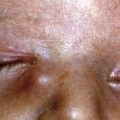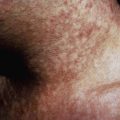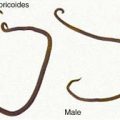Chapter 60 Evaluation of the Sick Child in the Office and Clinic
History
Fever is the most common reason for a sick child visit. Most fevers are the result of self-limited viral infections. However, pediatricians need to be aware of the age-dependent potential for serious bacterial infections (urinary tract infections, sepsis, meningitis, dysentery, osteoarticular infection). During the first 3 mo of life, the neonate is at risk for sepsis due to pathogens that are uncommon in older children. These organisms include group B streptococcus, Escherichia coli, Listeria monocytogenes, and herpes simplex virus. In neonates, the history must include maternal obstetric information and the patient’s birth history. Risk factors for sepsis include maternal group B streptococcus colonization, prematurity, chorioamnionitis, and prolonged rupture of membranes. If there is a maternal history of sexually transmitted infections during the pregnancy, the differential diagnosis must be expanded to include those pathogens. Septic infants can present with lethargy, poor feeding, grunting respirations, and impaired perfusion, in addition to fever. Infants with fever, irritability, and a bulging fontanel should be evaluated for meningitis. As the infant matures beyond 3 mo of age, the bacterial pathogens that usually cause bacteremia, sepsis, and meningitis are Streptococcus pneumoniae, H. influenzae type b (if the child is unimmunized or only partially immunized), and Neisseria meningitidis. Immunization against some serotypes of S. pneumoniae appears to be reducing the occurrence of occult bacteremia and serious infections caused by that organism, as has immunization against H. influenzae type b. Other ailments that manifest with fever include septic arthritis and osteomyelitis, juvenile rheumatoid arthritis, and Kawasaki disease. Children with a septic joint generally present with only one joint that is painful and often have pseudoparalysis of that joint. In contrast, patients with juvenile rheumatoid arthritis may present with pain, stiffness, swelling, and warmth of several joints. The diagnosis of Kawasaki disease should be considered if the patient meets the diagnostic criteria for this illness (Chapter 160).
Management
Most patients who present to the pediatrician’s office with an acute illness will not require resuscitation. The pediatrician needs to be prepared to evaluate and begin resuscitation for the seriously ill or unstable child. The pediatrician’s office should be stocked with appropriate equipment necessary to stabilize an acutely ill child. Maintenance of that equipment and ongoing training of the office staff in use of the equipment and procedures is required (Chapter 61). The evaluation must begin with assessment of the ABCs—airway, breathing, and circulation. When assessing the airway, chest rise should be evaluated, and evidence of increased work of breathing sought. The examiner should ensure that the trachea is midline. If the airway is patent and no signs of airway obstruction are present, the patient is allowed to assume a position of comfort. If the child shows signs of airway obstruction, repositioning of the head with the chin lift maneuver may alleviate the obstruction. An oral or nasal airway may be necessary in patients in whom airway patency cannot be maintained. These devices are not well tolerated in conscious patients and may induce gagging or vomiting. Once airway patency has been established, the adequacy of breathing should be evaluated. Auscultation of the lung fields should assess for air entry, symmetry of breath sounds, and presence of adventitious breath sounds such as crackles or wheezes. Pulse oximetry can be used to evaluate oxygenation. Bronchodilator therapy can be initiated to alleviate bronchospasm. Oxygen should be administered to all seriously ill children via nasal cannula or face mask. Cyanosis or slow respiratory rates may signal respiratory failure. If the airway is patent but the child’s respiratory effort is deemed inadequate, positive pressure ventilation via a bag-valve-mask device should be initiated. Once airway and breathing have been addressed, circulation must be evaluated. This involves assessment of cardiac output. Symptoms of shock include tachycardia, cool extremities, delayed capillary refill time, mottled or pale skin, and effortless tachypnea. Hypotension is a late finding in shock. Vascular access is necessary for volume resuscitation in patients with impaired circulation. Once an intervention is performed, the clinician must reassess the patient.
American Heart Association. 2005 American Heart Association (AHA) guidelines for cardiopulmonary resuscitation (CPR) and emergency cardiovascular care (ECC) of pediatric and neonatal patients: pediatric basic life support. Pediatrics. 2006;117:e989-e1004.
Fallot A. Respiratory distress. Pediatr Ann. 2005;34:885-891.
Ishimine P. Fever without source in children 0 to 36 months of age. Pediatr Clin North Am. 2006;53:167-194.
Ishimine P, Zorc JJ, Woodward GA. Sometimes it’s not so clear: altered mental status and transport. Pediatr Emerg Care. 2001;17:282-288.
Klig JE, O’Malley PJ. Pediatric office emergencies. Curr Opin Pediatr. 2007;19:591-596.
Loening-Baucke V, Swidsinski A. Constipation as cause of acute abdominal pain in children. J Pediatr. 2007;151:666-669.
Scholpeer SJ, Pituch K, Orr DP, et al. Clinical outcomes of children with acute abdominal pain. Pediatrics. 1996;98:680-685.
Stoll ML, Rubin LG. Incidence of occult bacteremia among highly febrile young children in the era of the pneumococcal conjugate vaccine: a study from a Children’s Hospital Emergency Department and Urgent Care Center. Arch Pediatr Adolesc Med. 2004;158:671-675.






